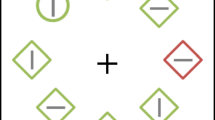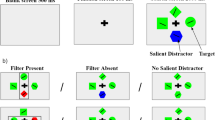Abstract
Rarely noticed in daily life, attention may prefer the left side of space. Such attentional biases offer key insights into functions of spatial attention and visual awareness because they complement pathological biases in patients with spatial neglect who become largely unaware of the left side after right-brain damage. Yet there is little comprehensive understanding of these normal and pathological biases and how they relate to other attentional functions. Here we used a grating-scales task (GST) to test whether leftward biases and their spatial frequency-dependent crossover interact with attentional mechanisms of distractor removal. We asked healthy participants to make perceptual judgements to capture attentional biases in a high and a low spatial frequency condition (GST-HI and GST-LO), and we degraded stimuli with distracting pixel noise. We found that with noise, crossover grew, while biases remained positively correlated. Using Monte Carlo simulations, we probed the feasibility of three models and conclude that our data can only be explained by two, or more, biasing mechanisms, arguably interacting with each other through interhemispheric competition. Our study sets the stage for a new systematic approach to investigating the visuospatial mechanisms of the right hemisphere.






Similar content being viewed by others
References
Anderson B (1996) A mathematical model of line bisection behavioural in neglect. Brain 119:841–850
Benwell CSY, Thut G, Learmonth G, Harvey M (2013) Spatial attention: differential shifts in pseudoneglect direction with time-on-task and initial bias support the idea of observer subtypes. Neuropsychologia 51:2747–2756
Benwell CSY, Harvey M, Thut G (2014) On the neural origin of pseudoneglect: EEG-correlates of shifts in line bisection bias with manipulation of line length. NeuroImage 86:370–380
Binder J, Marshall R, Lazar R, Benjamin J, Mohr JP (1992) Distinct syndromes of hemineglect. Arch Neurol 49:1187–1194
Bowers D, Heilman KM (1980) Pseudoneglect: effects of hemispace on a tactile line bisection task. Neuropsychologia 18(4–5):491–498
Brainard DH (1997) The psychophysics toolbox. Spat Vis 10:433–436
Bueti D, Walsh V (2009) The parietal cortex and the representation of time, space, number and other magnitudes. Philos Trans R Soc B Biol Sci 364:1831–1840
Campbell R, de Gelder B, de Hann E (1996) The lateralization of lip-reading: a second look. Neuropsychologia 34(12):1235–1240
Chatterjee A (1995) Cross-over, completion and confabulation in unilateral spatial neglect. Brain 118:455–465
Christman SD, Hackworth MD (1993) Equivalent perceptual asymmetries for free viewing of positive and negative emotional expressions in chimeric faces. Neuropsychologia 31:621–624
Corbetta M, Shulman GL (2002) Controls of goal-directed and stimulus-driven attention in the brain. Nat Neurosci 3(3):201–215
Cornelissen FW, Peters EM, Palmer J (2002) The Eyelink toolbox: eye tracking with MATLAB and the psychophysic toolbox. Behav Res Method Instrum Comput 34:613–617
Dehaene S, Bossini S, Giraux P (1993) The mental representation of parity and number magnitude. J Exp Psychol Gen 122:371–396
Della Sala S, Darling S, Logie RH (2010) Items on the left are better remembered. Quart J Exp Psychol 63:848–855
Ellison A, Schindler I, Pattison LL, Milner AD (2004) An exploration of the role of the superior temporal gyrus in visual search and spatial perception using TMS. Brain 127:2307–2315
Emrich SM, Burianova H, Ferber S (2011) Transient perceptual neglect: visual working memory load affects conscious object processing. J Cogn Neurosci 23(10):2968–2982
Fink GR, Marshall JC, Shah NJ, Weiss PH, Halligan PW, Grosse-Ruyken M, Ziemons K, Zilles K, Freund HJ (2000) Line bisection judgments implicate right parietal cortex and cerebellum as assessed by fMRI. Neurology 54(6):1324–1331
Foxe JJ, McCourt ME, Javitt DC (2003) Right hemisphere control of visuo-spatial attention: ‘Line-bisection’ judgments evaluated with high-density electrical mapping and source-analysis. NeuroImage 19:710–726
Gobell J, Carrasco M (2005) Attention alters the appearance of spatial frequency and gap size. Psychol Sci 16(8):644–651
Halligan PW, Marshall JC (1988) How long is a piece of string? A study of line bisection in a case of visual neglect. Cortex 24:321–328
Harms V, Reese M, Elias LJ (2014) Lateral bias in theatre-seat choice. Lateral Asymmetries Body Brain Cogn 19(1):1–11
Hatin B, Sykes Tottenham L, Oriet C (2012) The relationship between collisions and pseudoneglect: is it right? Cortex 48(8):997–1008
He BJ, Snyder AZ, Vincent JL, Epstein A, Shulman GL, Corbetta M (2007) Breakdown of functional connectivity in frontoparietal networks underlies behavioural deficits in spatial neglect. Neuron 53:905–918
Heilman KM, Van Den Abell T (1980) Right hemisphere dominance for attention: the mechanism underlying hemispheric asymmetries of inattention (neglect). Neurology 30:327–330
Hilgetag CC, Theoret H, Pascual-Leone A (2001) Enhanced visual spatial attention ipsilateral to rTMS-induced ‘virtual lesions’ of human parietal cortex. Nat Neurosci 4:953–957
Karnath HO, Ferber S, Himmelbach M (2001) Spatial awareness is a function of the temporal not the posterior parietal lobe. Nature 411:950–953
Karnath HO, Rorden C, Ticini LF (2009) Damage to white matter fiber tracts in acute spatial neglect. Cereb Cortex 19:2331–2337
Kinsbourne M (1977) Hemi-neglect and hemisphere rivalry. Adv Neurol 18:41–49
Kinsbourne M (1993) Orientational bias model of unilateral neglect: evidence from attentional gradients within hemispace. In: Robertson IH, Marshall JC (eds) Unilateral neglect: clinical and experimental studies. Lawrence Erlbaum, Hove, pp 63–86
Kitterle FL, Hellige JB, Christman S (1992) Visual hemispheric asymmetries depend on which spatial frequencies are task relevant. Brain Cogn 20:308–314
Koch G, Oliveri M, Cheeran B, Ruge D, Gerfo EL, Salerno S, Torriero S, Marconi B, Mori F, Driver J, Rothwell JC, Caltagirone C (2008) Hyperexcitability of parietal-motor functional connections in the intact left-hemisphere of patients with neglect. Brain 131(12):3147–3155
Le A, Niemeier M (2013a) A right hemisphere dominance for bimanual grasps. Exp Brain Res 224:263–273
Le A, Niemeier M (2013b) Left visual field preference for a bimanual grasping task with an ecologically valid object sizes. Exp Brain Res 230(2):187–196
Le A, Stojanoski B, Khan S, Keough M, Niemeier M The attentional bias is a function of the ventral attentional network: transient interhemispheric competition as the signature of spatial attention and visual awareness. Submitted to Cortex
Lu ZL, Dosher BA (1998) External noise distinguishes attention mechanisms. Vision Res 38:1183–1198
Manly T, Dobler VB, Dodds CM, George MA (2005) Rightward shift in spatial awareness with declining alertness. Neuropsychologia 43:1721–1728
Marshall JC, Halligan PW (1989) When right goes left: an investigation of line bisection in a case of visual neglect. Cortex 25:503–515
Mattingley JB, Bradshaw JL, Nettleton NC, Bradshaw JA (1994) Can task specific perceptual bias be distinguished from unilateral neglect? Neuropsychologia 32(7):805–817
Mattingley JB, Berberovic N, Corben L, Slavin MJ, Nicholls ME, Bradshaw JL (2004) The greyscales task: a perceptual measure of attentional bias following unilateral hemispheric damage. Neuropsychologia 42:387–394
McCourt ME, Jewell G (1999) Visuospatial attention in line bisection: stimulus modulation of pseudoneglect. Neuropsychologia 37:843–855
McCourt ME, Garlinghouse M, Reuter-Lorenz PA (2005) Unilateral visual cueing and asymmetric line geometry share a common attentional origin in the modulation of pseudoneglect. Cortex 41(4):499–511
Mennemeier M, Rapcsak SZ, Dillon M, Vezey E (1998) A search for the optimal stimulus. Brain Cogn 37:439–459
Mennemeier M, Pierce CA, Chatterjee A, Anderson B, Jewell G, Woods AJ, Glenn T, Mark VW (2005) Biases in attentional orientation and magnitude estimation explain crossover: neglect is a disorder of both. J Cogn Neurosci 17:1194–1211
Mesulam MM (1981) A cortical network for directed attention and unilateral neglect. Ann Neurol 10:309–325
Monaghan P, Shillcock R (1998) The cross-over effect in unilateral neglect. Modelling detailed data in the line-bisection task. Brain 121:907–921
Monaghan P, Shillcock R (2004) Hemispheric asymmetries in cognitive modelling: connectionist modelling of unilateral visual neglect. Psychol Rev 111(2):283–308
Mort DJ, Malhotra P, Mannan SK, Rorden C, Pambakian A, Kennard C, Husain M (2003) The anatomy of visual neglect. Brain 126:1986–1997
Mozer MC, Halligan PW, Marshall JC (1997) The end of the line for a brain-damaged model of unilateral neglect. J Cogn Neurosci 9(2):171–190
Nicholls MER, Loftus A, Mayer K, Mattingley JB (2007) Things that go bump in the right: the effect of unimanual activity on the rightward collisions. Neuropsychologia 45:1122–1126
Niemeier M, Stojanoski B, Greco AL (2007) Influences of time and spatial frequency on the perceptual bias: evidence for competition between hemispheres. Neuropsychologia 45(5):1029–1040
Niemeier M, Stojanoski B, Singh VWA, Chu E (2008a) Paradoxical cross-over due to attention to high or low spatial frequencies. Brain Cogn 67(1):115–124
Niemeier M, Singh VWA, Keough M, Akbar N (2008b) The perceptual consequences of the attentional bias: evidence for distractor removal. Exp Brain Res 189(4):411–420
O’Connell RG, Schneider D, Hester R, Mattingley JB, Bellgrove MA (2011) Attentional load asymmetrically affects early electrophysiological indices of visual orienting. Cereb Cortex 21(5):1056–1065
Oldfield RC (1971) The assessment and analysis of handedness: the Edinburgh inventory. Neuropsychologia 9:97–113
Pelli DG (1997) The VideoToolbox software for visual psychophysics: transforming numbers into movies. Spat Vis 10:437–442
Platt JR (1964) Strong inference: certain systematic methods of scientific thinking may produce much more rapid progress than others. Science 146:347–353
Rorden C, Fruhmann Berger M, Karnath HO (2006) Disturbed line bisection is associated with posterior brain lesions. Brain Res 1080:17–25
Rovamo J, Virsu V, Nasanen R (1978) Cortical magnification factor predicts the photopic contrast sensitivity of peripheral vision. Nature 271:54–56
Rusconi E, Walsh V, Butterworth B (2005) Dexterity with numbers: rTMS over left angular gyrus disrupts finger gnosis and number processing. Neuropsychologia 43:1609–1624
Schenkenberg T, Bradford DC, Ajax ET (1980) Line bisection and unilateral visual neglect in patients with neurologic impairment. Neurology 30(5):509–517
Singh VWA, Stojanoski B, Le A, Niemeier M (2011) Spatial frequency-specific effects on the attentional bias: evidence for two attentional systems. Cortex 47(5):547–556
Tegner R, Levander M (1991) Through a looking glass. A new technique to demonstrate directional hypokinesia in unilateral neglect. Brain 114:1943–1951
Thiebaut de Schotten M, Urbanski M, Duffau H, Volle E, Levy R, Dubois B, Bartolomeo R (2005) Direct evidence for a parietal-frontal pathway subserving spatial awareness in humans. Science 309:2226–2228
Thiebaut de Schotten M, Dell’Acqua F, Forkel SJ, Simmons A, Vergani F, Murphy DG, Catani M (2011) A lateralized brain network for visuospatial attention. Nat Neurosci 14:1245–1246
Todd JJ, Fougnie D, Marois R (2005) Visual short-term memory load suppresses temporo-parietal junction activity and induces inattentional blindness. Psychol Sci 16:965–972
Valadao DF, Hurwitz M, Danckert J (2010) Examining the influence of ‘noise’ on judgements of spatial extent. Exp Brain Res 207:157–164
Vallar G, Perani D (1986) The anatomy of unilateral neglect after right-hemisphere stroke lesions: a clinical/CT-scan correlation study in man. Neuropsychologia 24(5):609–622
Verdon V, Schwartz S, Lovblad KO, Hauert CA, Vuilleumier P (2010) Neuroanatomy of hemispatial neglect and its functional components: a study using voxel-based lesion-symptom mapping. Brain 133:880–894
Walsh V (2003) A theory of magnitude: common cortical metrics of time, space and quality. Trend Cogn Sci 7(11):483–488
Woods AJ, Mennemeier M, Garcia-Rill E, Meythaler J, Mark VW, Jewel GR, Murphy H (2006) Bias in magnitude estimation following left hemisphere injury. Neuropsychologia 44:1406–1412
Zorzi M, Priftis K, Umilta C (2002) Neglect disrupts the mental number line. Nature 417:138–139
Acknowledgments
We thank Ada Le and Adam Frost for comments on an early version of this manuscript. This work is supported by NSERC.
Author information
Authors and Affiliations
Corresponding author
Appendices
Appendix 1: Matlab function “model_GST_123.m” for computer simulations






Appendix 2: Matlab sub-function “exponentialFit.m” for exponential fits

Rights and permissions
About this article
Cite this article
Chen, J., Niemeier, M. Distractor removal amplifies spatial frequency-specific crossover of the attentional bias: a psychophysical and Monte Carlo simulation study. Exp Brain Res 232, 4001–4019 (2014). https://doi.org/10.1007/s00221-014-4082-y
Received:
Accepted:
Published:
Issue Date:
DOI: https://doi.org/10.1007/s00221-014-4082-y




